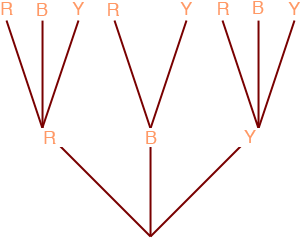| |||
| Math Central | Quandaries & Queries |
|
Question from Inez, a student: A box contains 3 red blocks and 1 green block. A block is chosen without looking and not put back. Then another block is chosen. What are the possible outcomes? |
Hi Inez,
I am going to do a slightly different problem.
A box contains 3 red blocks, 1 black block and 4 yellow blocks. A block is chosen without looking and not put back. Then another block is chosen. What are the possible outcomes?
The subject line of your email was "tree diagrams" so I drew a tree diagram to illustrate the process.

On the first draw, the lower level of the tree, I can draw a red, black or yellow block. If I draw a red or yellow block an the first draw I can draw either a red, black or yellow block on the second draw. However if I draw a black block on the first draw then I can only draw a red or yellow block on the second draw since there is only one black block.
I don't know what to say about the possible outcomes because I don't know if order is important. That is if you end up with a red block and a black block does it matter which you got on the first draw? If so then there are 8 possible outcomes.
| First block | Second block |
|---|---|
| red | red |
| red | black |
| red | yellow |
| black | red |
| black | yellow |
| yellow | red |
| yellow | black |
| yellow | yellow |
This is only a guess on my part but my guess is that your teacher is expecting you to consider that order is not important, just what two colours you have drawn. If this is o there are 5 possible outcomes
{red, red}
{red, black}
{red, yellow}
{black, yellow} and
{yellow, yellow}
I hope this helps,
Penny
 |
||
Math Central is supported by the University of Regina and The Pacific Institute for the Mathematical Sciences.